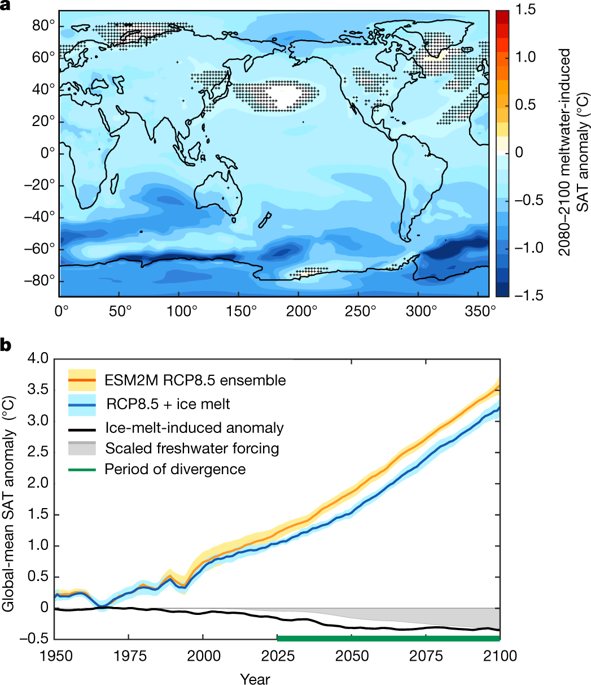Our official English website, www.x-mol.net, welcomes your feedback! (Note: you will need to create a separate account there.)
Change in future climate due to Antarctic meltwater
Nature ( IF 64.8 ) Pub Date : 2018-11-19 , DOI: 10.1038/s41586-018-0712-z Ben Bronselaer , Michael Winton , Stephen M. Griffies , William J. Hurlin , Keith B. Rodgers , Olga V. Sergienko , Ronald J. Stouffer , Joellen L. Russell
Nature ( IF 64.8 ) Pub Date : 2018-11-19 , DOI: 10.1038/s41586-018-0712-z Ben Bronselaer , Michael Winton , Stephen M. Griffies , William J. Hurlin , Keith B. Rodgers , Olga V. Sergienko , Ronald J. Stouffer , Joellen L. Russell

|
Meltwater from the Antarctic Ice Sheet is projected to cause up to one metre of sea-level rise by 2100 under the highest greenhouse gas concentration trajectory (RCP8.5) considered by the Intergovernmental Panel on Climate Change (IPCC). However, the effects of meltwater from the ice sheets and ice shelves of Antarctica are not included in the widely used CMIP5 climate models, which introduces bias into IPCC climate projections. Here we assess a large ensemble simulation of the CMIP5 model ‘GFDL ESM2M’ that accounts for RCP8.5-projected Antarctic Ice Sheet meltwater. We find that, relative to the standard RCP8.5 scenario, accounting for meltwater delays the exceedance of the maximum global-mean atmospheric warming targets of 1.5 and 2 degrees Celsius by more than a decade, enhances drying of the Southern Hemisphere and reduces drying of the Northern Hemisphere, increases the formation of Antarctic sea ice (consistent with recent observations of increasing Antarctic sea-ice area) and warms the subsurface ocean around the Antarctic coast. Moreover, the meltwater-induced subsurface ocean warming could lead to further ice-sheet and ice-shelf melting through a positive feedback mechanism, highlighting the importance of including meltwater effects in simulations of future climate.Accounting for meltwater from the Antarctic Ice Sheet in simulations of global climate leads to substantial changes in future climate projections and identifies a potential feedback mechanism that exacerbates melting.
中文翻译:

南极融水导致未来气候变化
在政府间气候变化专门委员会 (IPCC) 考虑的最高温室气体浓度轨迹 (RCP8.5) 下,预计到 2100 年,南极冰盖的融水将导致海平面上升一米。然而,南极洲冰盖和冰架融水的影响并未包括在广泛使用的 CMIP5 气候模型中,这会给 IPCC 气候预测带来偏差。在这里,我们评估了 CMIP5 模型“GFDL ESM2M”的大型集成模拟,该模型解释了 RCP8.5 预测的南极冰盖融水。我们发现,相对于标准 RCP8.5 情景,考虑融水将超过 1.5 摄氏度和 2 摄氏度的全球平均大气变暖最大目标延迟了十多年,加强南半球的干燥并减少北半球的干燥,增加南极海冰的形成(与最近南极海冰面积增加的观察结果一致)并使南极海岸周围的地下海洋变暖。此外,融水引起的地下海洋变暖可能通过正反馈机制导致冰盖和冰架进一步融化,突出了在未来气候模拟中包含融水效应的重要性。 在模拟中考虑来自南极冰盖的融水全球气候的变化导致未来气候预测发生重大变化,并确定了加剧融化的潜在反馈机制。增加南极海冰的形成(与最近南极海冰面积增加的观察结果一致)并使南极海岸周围的地下海洋变暖。此外,融水引起的地下海洋变暖可能通过正反馈机制导致冰盖和冰架进一步融化,突出了在未来气候模拟中包含融水效应的重要性。 在模拟中考虑来自南极冰盖的融水全球气候的变化导致未来气候预测发生重大变化,并确定了加剧融化的潜在反馈机制。增加南极海冰的形成(与最近南极海冰面积增加的观察结果一致)并使南极海岸周围的地下海洋变暖。此外,融水引起的地下海洋变暖可能通过正反馈机制导致冰盖和冰架进一步融化,突出了在未来气候模拟中包含融水效应的重要性。 在模拟中考虑来自南极冰盖的融水全球气候的变化导致未来气候预测发生重大变化,并确定了加剧融化的潜在反馈机制。
更新日期:2018-11-19
中文翻译:

南极融水导致未来气候变化
在政府间气候变化专门委员会 (IPCC) 考虑的最高温室气体浓度轨迹 (RCP8.5) 下,预计到 2100 年,南极冰盖的融水将导致海平面上升一米。然而,南极洲冰盖和冰架融水的影响并未包括在广泛使用的 CMIP5 气候模型中,这会给 IPCC 气候预测带来偏差。在这里,我们评估了 CMIP5 模型“GFDL ESM2M”的大型集成模拟,该模型解释了 RCP8.5 预测的南极冰盖融水。我们发现,相对于标准 RCP8.5 情景,考虑融水将超过 1.5 摄氏度和 2 摄氏度的全球平均大气变暖最大目标延迟了十多年,加强南半球的干燥并减少北半球的干燥,增加南极海冰的形成(与最近南极海冰面积增加的观察结果一致)并使南极海岸周围的地下海洋变暖。此外,融水引起的地下海洋变暖可能通过正反馈机制导致冰盖和冰架进一步融化,突出了在未来气候模拟中包含融水效应的重要性。 在模拟中考虑来自南极冰盖的融水全球气候的变化导致未来气候预测发生重大变化,并确定了加剧融化的潜在反馈机制。增加南极海冰的形成(与最近南极海冰面积增加的观察结果一致)并使南极海岸周围的地下海洋变暖。此外,融水引起的地下海洋变暖可能通过正反馈机制导致冰盖和冰架进一步融化,突出了在未来气候模拟中包含融水效应的重要性。 在模拟中考虑来自南极冰盖的融水全球气候的变化导致未来气候预测发生重大变化,并确定了加剧融化的潜在反馈机制。增加南极海冰的形成(与最近南极海冰面积增加的观察结果一致)并使南极海岸周围的地下海洋变暖。此外,融水引起的地下海洋变暖可能通过正反馈机制导致冰盖和冰架进一步融化,突出了在未来气候模拟中包含融水效应的重要性。 在模拟中考虑来自南极冰盖的融水全球气候的变化导致未来气候预测发生重大变化,并确定了加剧融化的潜在反馈机制。



























 京公网安备 11010802027423号
京公网安备 11010802027423号